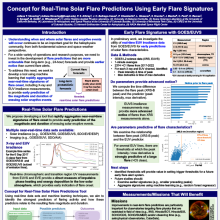Concept for Real-Time Solar Flare Predictions Using Early Flare Signatures
Juliana
Vievering
Johns Hopkins Applied Physics Laboratory
Poster
Understanding when and where extreme solar flares and eruptive events will occur continues to be an important goal for the heliophysics community, from both fundamental science and space weather perspectives. Currently available flare forecasts typically fall into two main categories: (1) long-term probabilistic forecasts (e.g., probability that a flare of a certain magnitude is going to occur over the next 24 hours), and (2) flare alerts (e.g., notification when GOES X-ray flux reaches a high threshold). For a wide variety of operations and research purposes, there is an additional need for flare predictions that are more actionable than long-term forecasts and provide earlier notice of extreme events than current flare alerts do. To address this need, we seek to develop a tool using machine learning that rapidly aggregates near-real-time signatures of flare onset, including X-ray and EUV irradiance measurements, to provide early prediction of the magnitude and duration of ensuing solar eruptive events. In particular, real-time chromospheric and transition region measurements from GOES EUVS provide a direct measure of impulsive phase heating and energy deposition in the low solar atmosphere as an early indication of flare onset. Such a tool will provide crucial notice (~minutes) prior to the arrival of harmful radiation in near-Earth space to mitigate effects on astronauts and radio communications and will enable triggered observations of scientifically interesting events. Here we present our concept for real-time solar flare predictions and preliminary analysis of real-time EUV irradiance data from GOES EUVS for this application.

Poster PDF
Poster category
Solar and Interplanetary Research and Applications
Meeting homepage